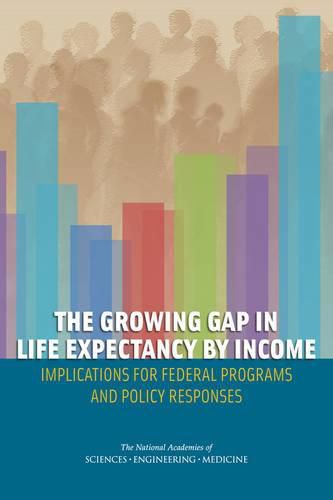The Growing Gap in Life Expectancy by Income: Implications for Federal Programs and Policy Responses
National Academies of Sciences, Engineering, and Medicine,Division on Engineering and Physical Sciences,Board on Mathematical Sciences and Their Applications,Division of Behavioral and Social Sciences and Education,Committee on Population

The Growing Gap in Life Expectancy by Income: Implications for Federal Programs and Policy Responses
National Academies of Sciences, Engineering, and Medicine,Division on Engineering and Physical Sciences,Board on Mathematical Sciences and Their Applications,Division of Behavioral and Social Sciences and Education,Committee on Population
The U.S. population is aging. Social Security projections suggest that between 2013 and 2050, the population aged 65 and over will almost double, from 45 million to 86 million. One key driver of population aging is ongoing increases in life expectancy. Average U.S. life expectancy was 67 years for males and 73 years for females five decades ago; the averages are now 76 and 81, respectively. It has long been the case that better-educated, higher-income people enjoy longer life expectancies than less-educated, lower-income people. The causes include early life conditions, behavioral factors (such as nutrition, exercise, and smoking behaviors), stress, and access to health care services, all of which can vary across education and income.
Our major entitlement programs - Medicare, Medicaid, Social Security, and Supplemental Security Income - have come to deliver disproportionately larger lifetime benefits to higher-income people because, on average, they are increasingly collecting those benefits over more years than others. This report studies the impact the growing gap in life expectancy has on the present value of lifetime benefits that people with higher or lower earnings will receive from major entitlement programs. The analysis presented in The Growing Gap in Life Expectancy by Income goes beyond an examination of the existing literature by providing the first comprehensive estimates of how lifetime benefits are affected by the changing distribution of life expectancy. The report also explores, from a lifetime benefit perspective, how the growing gap in longevity affects traditional policy analyses of reforms to the nation’s leading entitlement programs. This in-depth analysis of the economic impacts of the longevity gap will inform debate and assist decision makers, economists, and researchers.
This item is not currently in-stock. It can be ordered online and is expected to ship in approx 4 weeks
Our stock data is updated periodically, and availability may change throughout the day for in-demand items. Please call the relevant shop for the most current stock information. Prices are subject to change without notice.
Sign in or become a Readings Member to add this title to a wishlist.

